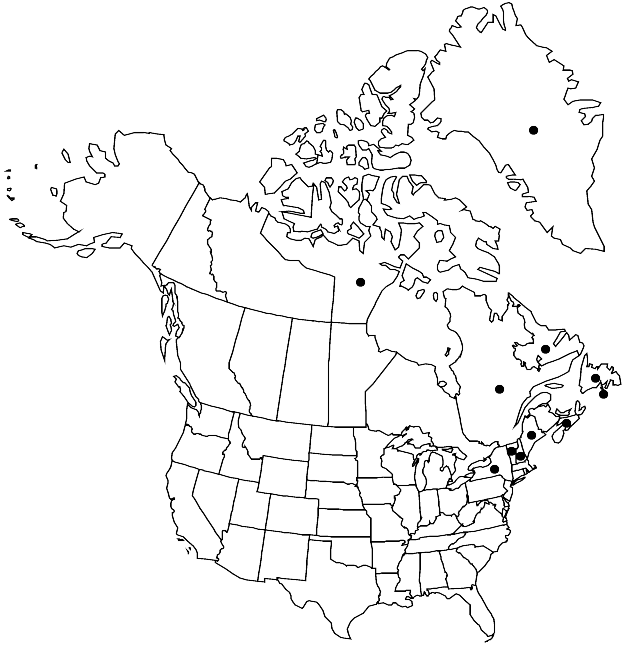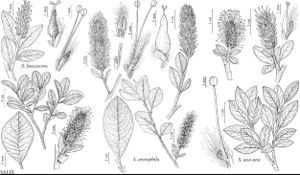Difference between revisions of "Salix uva-ursi"
Fl. Amer. Sept. 2: 610. 1813.
FNA>Volume Importer |
imported>Volume Importer |
||
| (3 intermediate revisions by 2 users not shown) | |||
| Line 8: | Line 8: | ||
}} | }} | ||
|common_names=Bearberry willow | |common_names=Bearberry willow | ||
| + | |special_status={{Treatment/ID/Special_status | ||
| + | |code=F | ||
| + | |label=Illustrated | ||
| + | }}{{Treatment/ID/Special_status | ||
| + | |code=E | ||
| + | |label=Endemic | ||
| + | }} | ||
|basionyms= | |basionyms= | ||
|synonyms={{Treatment/ID/Synonym | |synonyms={{Treatment/ID/Synonym | ||
|name=Salix ivigtutiana | |name=Salix ivigtutiana | ||
|authority=Lundström | |authority=Lundström | ||
| + | |rank=species | ||
}} {{Treatment/ID/Synonym | }} {{Treatment/ID/Synonym | ||
|name=Salix myrsinites var. parvifolia | |name=Salix myrsinites var. parvifolia | ||
|authority=Lange | |authority=Lange | ||
| + | |rank=variety | ||
}} | }} | ||
|hierarchy=Salicaceae;Salix;Salix subg. Chamaetia;Salix sect. Myrtosalix;Salix uva-ursi | |hierarchy=Salicaceae;Salix;Salix subg. Chamaetia;Salix sect. Myrtosalix;Salix uva-ursi | ||
| Line 40: | Line 49: | ||
-->{{#Taxon: | -->{{#Taxon: | ||
name=Salix uva-ursi | name=Salix uva-ursi | ||
| − | |||
|authority=Pursh | |authority=Pursh | ||
|rank=species | |rank=species | ||
| Line 54: | Line 62: | ||
|publication title=Fl. Amer. Sept. | |publication title=Fl. Amer. Sept. | ||
|publication year=1813 | |publication year=1813 | ||
| − | |special status= | + | |special status=Illustrated;Endemic |
| − | |source xml=https:// | + | |source xml=https://bitbucket.org/aafc-mbb/fna-data-curation/src/2e0870ddd59836b60bcf96646a41e87ea5a5943a/coarse_grained_fna_xml/V7/V7_72.xml |
|genus=Salix | |genus=Salix | ||
|subgenus=Salix subg. Chamaetia | |subgenus=Salix subg. Chamaetia | ||
Latest revision as of 22:35, 5 November 2020
Plants 0.01–0.05 m, (dwarf), forming clonal compact mats by layering. Stems prostrate, short-trailing; branches red-brown, gray-brown, or yellow-brown, glabrous; branchlets yellow-green or yellow-brown, glabrous or puberulent. Leaves: stipules (sometimes marcescent) absent, rudimentary, or foliaceous on early ones, foliaceous on late ones; petiole (shallowly to deeply grooved adaxially), 2–6.5 mm; largest medial blade (marcescent), amphistomatous or hypostomatous, ovate, broadly obovate, oblanceolate, or elliptic, 4–23 × 3.5–10 mm, 1.7–3.6 times as long as wide, base convex or cuneate, margins flat, serrulate or crenulate, apex convex, acuminate, acute, or retuse, abaxial surface glaucous, usually glabrous (rarely few hairs), adaxial slightly or highly glossy, usually glabrous (rarely a few hairs); proximal blade margins entire or serrate; juvenile blade glabrous, pilose, or puberulent abaxially. Catkins: staminate 9–19 × 5–8 mm, flowering branchlet 0.5–9 mm; pistillate densely flowered, slender to subglobose, 11–47(–55 in fruit) × 6–10 mm, flowering branchlet 2–10 mm; floral bract brown, black, tawny, light rose, or bicolor, 1.1–1.8 mm, apex rounded or acute, entire, abaxially sparsely hairy, hairs straight or wavy. Staminate flowers: abaxial nectary absent, adaxial nectary narrowly oblong or oblong, 0.4–0.9 mm; filaments distinct, glabrous; stamens usually 1, rarely 2; anthers ellipsoid or shortly cylindrical, 0.4–0.7 mm. Pistillate flowers: abaxial nectary absent, adaxial nectary narrowly oblong or oblong, 0.5–0.8 mm, shorter to longer than stipe; stipe 0.3–1.6 mm; ovary ovoid or pyriform, glabrous, beak gradually tapering to styles; ovules 4–9 per ovary; styles 0.4–1 mm; stigmas flat, abaxially non-papillate with rounded tip, or slenderly cylindrical, 0.1–0.23–0.4 mm. Capsules 3–5 mm. 2n = 38.
Phenology: Flowering mid Jun-early Aug.
Habitat: Exposed, often dry or moist, calcareous, serpentine, dioritic, and granitic rocks, boulders, gravel, sand on beaches, outcrops, in snowbeds
Elevation: 10-1200 m
Distribution

Greenland, St. Pierre and Miquelon, Nfld. and Labr., N.S., Nunavut, Que., Maine, N.H., N.Y., Vt.
Discussion
Hybrids:
Salix uva-ursi forms natural hybrids with S. herbacea.
Selected References
None.
